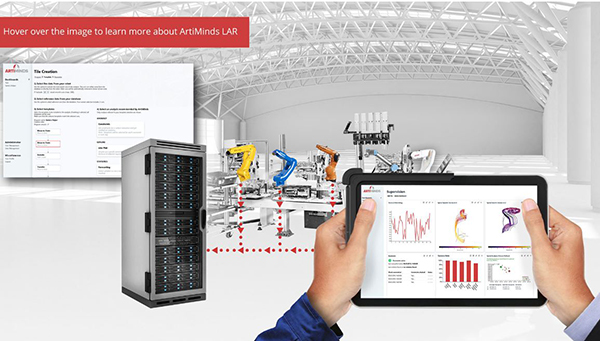ArtiMinds LAR

WHAT IS ARTIMINDS LEARNING & ANALYTICS FOR ROBOTS?
Monitor, analyze and optimize live sensor data
With ArtiMinds Learning & Analytics for Robots (LAR) you will gain detailed insights into your production processes with robots. Building on top of ArtiMinds RPS, live sensor data from the robot, force-torque sensor, vision system and end-effector will be obtained automatically from the robot controller. The sensor data can be tagged automatically and will be stored permanently in your in-house database.
Easily set up multiple dashboards to analyze the sensor data using different KPIs and tiles. A large set of tiles enables you to monitor the production, inspect a robot motion and optimize your robot program.
Automatic data recording and long-term storage
Robot programs generated with ArtiMinds RPS are automatically set-up for data acquisition – without further programming effort. Record live data of the robot’s motion, error signals, force-torque-sensor- and gripper data as well as image processing results for every process cycle. This sensor data can be automatically tagged, e.g. with serial numbers, and will be split based on the templates of your robot program.
Review your production processes – even years after the production date. The sensor data of each process cycle is stored within your in-house database. The data storage is prepared for maintenance and continuous improvement of your production line: ArtiMinds LAR will automatically manage different versions of your robot program.
Analyze processes easily
Linking to the templates in your robot program, you can navigate through the sensor data of any process. In doing so, each building block serves to accomplish specific tasks. Each template solves a specific task within your process. ArtiMinds LAR uses this knowledge to automatically make suggestions for appropriate analysis tiles to you.
This approach saves setup time and the graphical visualization and process-related evaluation in ArtiMinds LAR enables the user to understand complex processes even without in-depth expert knowledge.
Manage multiple processes in 2D/3D
Dashboards can be deployed in a flexible manner: Aggregate information from different processes in a single dashboard or create a custom dashboard with detailed analyses for each sub-process separately. Choose the option that fits your processes the best.
You want to visualize your processes in 2D or 3D? That’s no problem either. For this purpose, you have a large number of corresponding tiles to choose from. If you want to analyze the force progressions along a robot path, we recommend displaying them in 3D diagrams. If, on the other hand, you would like to evaluate process tolerances, you can do this efficiently with 2D plots. However, your options are far from exhausted with this. With ArtiMinds LAR, the success rates of each template are displayable as easily as force-path diagrams of different assembly steps.
Easy error search and monitoring
Use process data generated in previous process cycles as a reference during the analysis of current sensor data or to pinpoint errors in your production. Detect anomalies like exceeding forces during the assembly of parts or critical deviations in part positioning. Receive comprehensive knowledge in a level of detail that seemed impossible until now.
Use constraints to monitor specific sub-processes to prevent downtime in your production and gain reaction time. You will automatically receive a push notification once a constraint is violated. Narrow down troubleshooting by inspecting the process cycle and its sensor data that led to the constraint violation.
Optimize cycle time
Avoid time-consuming manual optimization of the robot program through frequent reteaching already during commissioning or operation. Each sensor-adaptive robot program created with ArtiMinds RPS will adapt to process tolerances which guarantees a high degree of process reliability. Use automatically generated corrective robot motions of multiple process cycles to compute optimal robot positions and reduce cycle time.